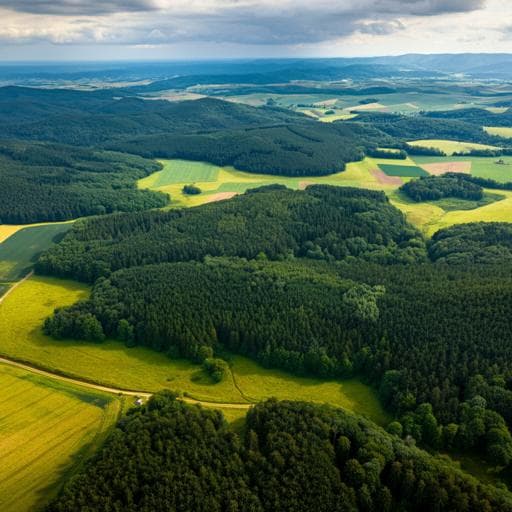
Environmental Studies and Forestry
Projected landscape-scale repercussions of global action for climate and biodiversity protection
P. J. V. Jeetze, I. Weindl, et al.
This research dives into innovative strategies for land conservation and carbon uptake, revealing that while ambitious restoration and protected area efforts are crucial, they may not be enough on their own. The study highlights the importance of maintaining semi-natural habitats within agricultural landscapes to bolster biodiversity without compromising productivity. Conducted by a team of experts including Patrick José von Jeetze and Isabelle Weindl, this work offers a path toward sustainable land use amidst growing agricultural demands.
~3 min • Beginner • English
Introduction
The study investigates how global efforts for climate mitigation and biodiversity conservation, alongside rising demand for land-based commodities, may drive landscape-scale changes that affect key regulating nature’s contributions to people (NCP) in agricultural areas outside protected zones. While the Paris Agreement and the Kunming-Montreal Global Biodiversity Framework could curb agricultural expansion, growing demand may intensify production within existing landscapes, exacerbating landscape simplification and trade-offs between material provisioning and regulating NCP such as pollination, pest control, soil protection, and climate regulation. Previous global land-system models often miss fine-scale drivers like landscape simplification, potentially biasing assessments. The research aims to evaluate whether area-based protection and carbon-focused land restoration alone can reverse negative trends in landscape heterogeneity, pollination supply, and soil loss, and to test whether adding landscape-level habitat retention targets can improve outcomes without compromising carbon or productivity.
Literature Review
Prior work demonstrates that landscape complexity (compositional and configurational heterogeneity) increases biodiversity and key NCP. Semi-natural habitats in farmed landscapes are strong predictors of wild pollination and pest control; their loss reduces these services and yields. Approximately 75% of global crop species depend on biotic pollination, placing substantial economic value at risk with pollinator declines, particularly in low-income countries. Structural diversity also mitigates soil erosion from wind and water. Landscape approaches combined with on-field practices (agroforestry, cover crops, reduced tillage, residue retention) are effective for soil protection. However, most integrated global land-use models emphasize coarse-scale dynamics and underrepresent landscape simplification, a key driver of biodiversity and NCP losses, risking imbalanced policy insights. Calls exist for integrating multiple spatial scales to better capture NCP dynamics and biodiversity responses in agricultural systems.
Methodology
The authors couple the global land-system model MAgPIE (v4.3.5) with the Spatial Economic Allocation Landscape Simulator (SEALS) to assess multi-scale land-use dynamics through 2050 under the SSP2 'middle-of-the-road' socioeconomic pathway. MAgPIE employs recursive dynamic cost optimization to allocate production of food, feed, bioenergy, and materials under biophysical and socioeconomic constraints, using LPJmL-derived yield patterns, water availability, and carbon stocks at 0.5° (~55 km) resolution. SEALS downscales MAgPIE land-cover changes to 10 arc seconds (~300 m) based on adjacency, physical suitability (soil organic carbon, terrain roughness), and conversion eligibility using ESA-CCI 2015 land cover as baseline.
Scenarios: (1) BAU (current national policies, no added climate/landscape interventions), (2) PROTECT (expand protected areas to cover ~30% of land by 2030 in biodiversity hotspots and intact forest landscapes), (3) COACTION (ambitious land-based climate policy consistent with 1.5°C, including NDC and carbon price-induced reforestation plus conservative bioenergy expansion to 7 EJ yr⁻¹ in 2050), (4) MULTI (COACTION measures plus a landscape policy retaining/restoring ≥20% semi-natural habitat in farmed landscapes by 2030). Climate impacts on yields/water were not included.
Indicators:
- Compositional heterogeneity: cropland fraction per 0.5° grid cell (with 90% cap on available potential cropland per cell).
- Pollination sufficiency (field-scale): proportion of semi-natural habitat (forest, non-forest vegetation, grassland) within 2 km of cropland pixels; sufficiency threshold at 30% habitat; scores scaled 0–1 (following Chaplin-Kramer et al.). Used as a proxy for wild pollination supply and configurational heterogeneity.
- Soil loss by water erosion (field-scale): GloSEM platform (RUSLE-based) estimating long-term annual erosion (Mg ha⁻¹ yr⁻¹) using rainfall erosivity (GloREDa), soil erodibility (ISRIC SoilGrids), topography (LS factor), and land cover/management (crop-specific C-factors from MAgPIE patterns; forest/non-forest vegetation cover from remote sensing). Soil conservation practices and climate-change-driven rainfall changes were held constant.
Carbon accounting: Net CO₂ exchange from land-use change includes carbon losses from conversion (soil, litter, vegetation) and uptake from reforestation and regrowth on abandoned agricultural land.
Analyses include global/regional aggregation, comparisons across scenarios, and sensitivity tests to exogenous parameters (trade liberalization, productivity investment costs, carbon price).
Key Findings
- Demand: By 2050, total demand for land-based commodities increases by 54%. Global food demand rises 35% (largest increases: Sub-Saharan Africa +123%, Middle East & North Africa +65%, India +56%). Demand for pollinator-dependent crops grows from 5.2 to 7.0 EJ yr⁻¹ (+34%); regional increases are pronounced in Sub-Saharan Africa (+222.5%), MENA (+84.7%), and India (+62.9%). Feed concentrates nearly double.
- Land use and productivity: In BAU, cropland expands by 439 Mha (2015–2050). Land-based climate action (COACTION, MULTI) reduces cropland expansion into natural land by more than two thirds relative to BAU. PROTECT only slightly slows cropland expansion globally. Average annual crop yield growth: 0.8% (BAU, PROTECT) vs 1.3% (COACTION, MULTI), all below the 1995–2015 rate (1.6%). The landscape policy (≥20% semi-natural habitat) triggers spatial relocation of cropland without increasing global cropland area or requiring extra yield gains.
- Natural ecosystems: Without climate action, substantial losses of primary/secondary forest and non-forest ecosystems occur, mainly from expansion in Sub-Saharan Africa and Latin America. PROTECT reduces primary forest loss to 30 Mha (vs 91 Mha in BAU) but sees higher secondary forest and other land losses due to leakage. COACTION and MULTI drastically curb expansion into natural lands; primary forest loss is halted at 22 Mha after 2030 in both. MULTI slightly reduces global losses of secondary forest (−1 Mha) and other land (−5 Mha) versus COACTION. Pasture/rangeland decline notably in China, Sub-Saharan Africa, Latin America due to both cropland shifts and reforestation. Reforestation area: COACTION 196 Mha; MULTI 195 Mha (below ~500 Mha feasible boundary).
- Carbon (NCP 4): PROTECT reduces annual net carbon losses by 34% vs BAU, despite only ~6% less natural land loss, indicating synergy between biodiversity protection and mitigation. COACTION converts the land system to a net carbon sink by 2050. MULTI’s spatial cropland relocation causes negligible additional carbon losses; 2050 net carbon uptake: COACTION 233 Mt CO₂ yr⁻¹, MULTI 223 Mt CO₂ yr⁻¹.
- Landscape heterogeneity (compositional): In 2015, 399 Mha (24%) of cropland lie in highly homogeneous grid cells (cropland fraction 0.8–1). By 2050, cropland in such cells increases: BAU +66% to 662 Mha; PROTECT +33%; COACTION +13%. In MULTI, grid-cell cropland fractions stay ≤0.8 due to the landscape policy.
- Pollination supply/configurational heterogeneity: In 2015, nearly half of cropland (915 Mha) has low pollination sufficiency, and ~687 Mha has high sufficiency. By 2050, low-sufficiency cropland area increases in BAU, PROTECT, COACTION, but less so in COACTION. MULTI is the only scenario with a net reduction in cropland with low sufficiency, though 849 Mha remain low. In historic croplands, drops from the highest sufficiency class: BAU 51 Mha, PROTECT 50 Mha, COACTION 34 Mha; MULTI shows only marginal net reduction. Results are robust to excluding grassland as semi-natural habitat.
- Soil loss by water erosion (NCP 8): Baseline (2015) global soil loss is ~44 Pg yr⁻¹, ~half from croplands. By 2050, BAU increases cropland soil loss by +21 Pg yr⁻¹. Strong synergies with climate action reduce soil loss by −16 Pg yr⁻¹ vs BAU (due to less cropland expansion and more second-generation bioenergy crops offering better soil cover). PROTECT yields −3 Pg yr⁻¹ vs BAU via less expansion in erosion-prone tropics. The landscape policy reduces soil loss in historic croplands but raises overall soil loss relative to COACTION due to relocation to more erosion-susceptible areas. Largest regional soil-loss changes occur in Latin America, Asia, Sub-Saharan Africa, and the USA; synergies with climate action are evident in Sub-Saharan Africa and China (marginal increases in COACTION and MULTI).
Overall, area-based protection and carbon-focused restoration alone do not reverse declines in landscape heterogeneity and pollination; adding a ≥20% semi-natural habitat target improves NCP and biodiversity-related indicators without additional net carbon losses, primary land conversion, or reduced productivity, though it may shift erosion risks spatially.
Discussion
The study demonstrates that rising demand for food and materials, if addressed without targeted landscape measures, perpetuates landscape simplification and soil degradation, undermining regulating NCP crucial for long-term agricultural productivity and resilience. Area-based conservation and land-based climate action provide substantial benefits for carbon and reduce conversion of natural ecosystems, but alone they are insufficient to reverse negative trends in landscape heterogeneity and pollination supply within farmed landscapes. Integrating a landscape policy to retain or restore ≥20% semi-natural habitat can enhance configurational and compositional heterogeneity and pollination sufficiency without causing additional net carbon losses, primary land conversion, or reductions in agricultural productivity. However, implementing such measures entails cropland relocation, raising distributional and socio-political considerations and potential increases in soil loss in some relocated areas. Effective policy packages should therefore combine protection, climate action, and landscape-scale habitat retention with safeguards to prevent leakage into sensitive areas, compensation mechanisms, and promotion of soil conservation practices. The findings underscore the value of multi-scale modelling to reveal landscape-level repercussions of global policy, informing designs that jointly advance climate mitigation, biodiversity conservation, and sustainable production.
Conclusion
Coupling global land-use optimization (MAgPIE) with fine-scale allocation (SEALS) and NCP indicators reveals that while conservation expansion and ambitious land-based climate action significantly reduce natural habitat conversion and turn the land sector into a carbon sink, they do not by themselves reverse declines in landscape heterogeneity and pollination supply. Adding a quantitative landscape target—retaining/restoring at least 20% semi-natural habitat in farmed landscapes—can deliver co-benefits for biodiversity and key regulating NCP without additional carbon penalties or yield intensification requirements, though it necessitates spatial cropland relocation and careful management of erosion risks. Future research should integrate feedbacks from NCP changes on productivity (e.g., pollination deficits, soil erosion impacts), represent climate-change effects on erosion and yields, assess the quality and spatial configuration of semi-natural habitats (including edge effects), capture the structural effects of bioenergy crops on landscape and pollination, and evaluate socio-economic distributional outcomes to inform equitable, context-sensitive implementation.
Limitations
- Fine-scale land allocation is anchored to current land-use patterns, potentially yielding lower-bound estimates of NCP provisioning; targeted ecosystem management and spatial planning could further improve outcomes.
- Semi-natural habitat quality is simplified (forest, non-forest, grassland); variability in management, structure, and edge effects on carbon stocks and biodiversity are not represented.
- Second-generation bioenergy crops are considered for soil loss but not for effects on landscape structure and pollination due to model constraints.
- Feedbacks from NCP changes to agricultural productivity (e.g., pollination shortfalls, soil erosion impacts) are not modeled dynamically.
- Climate-change impacts on rainfall erosivity and soil conservation practices are held constant; climate impacts on crop yields and water were out of scope.
- Social, cultural, and political enabling conditions and distributional consequences of cropland relocation are not modeled and require complementary policy analysis.
Related Publications
Explore these studies to deepen your understanding of the subject.







